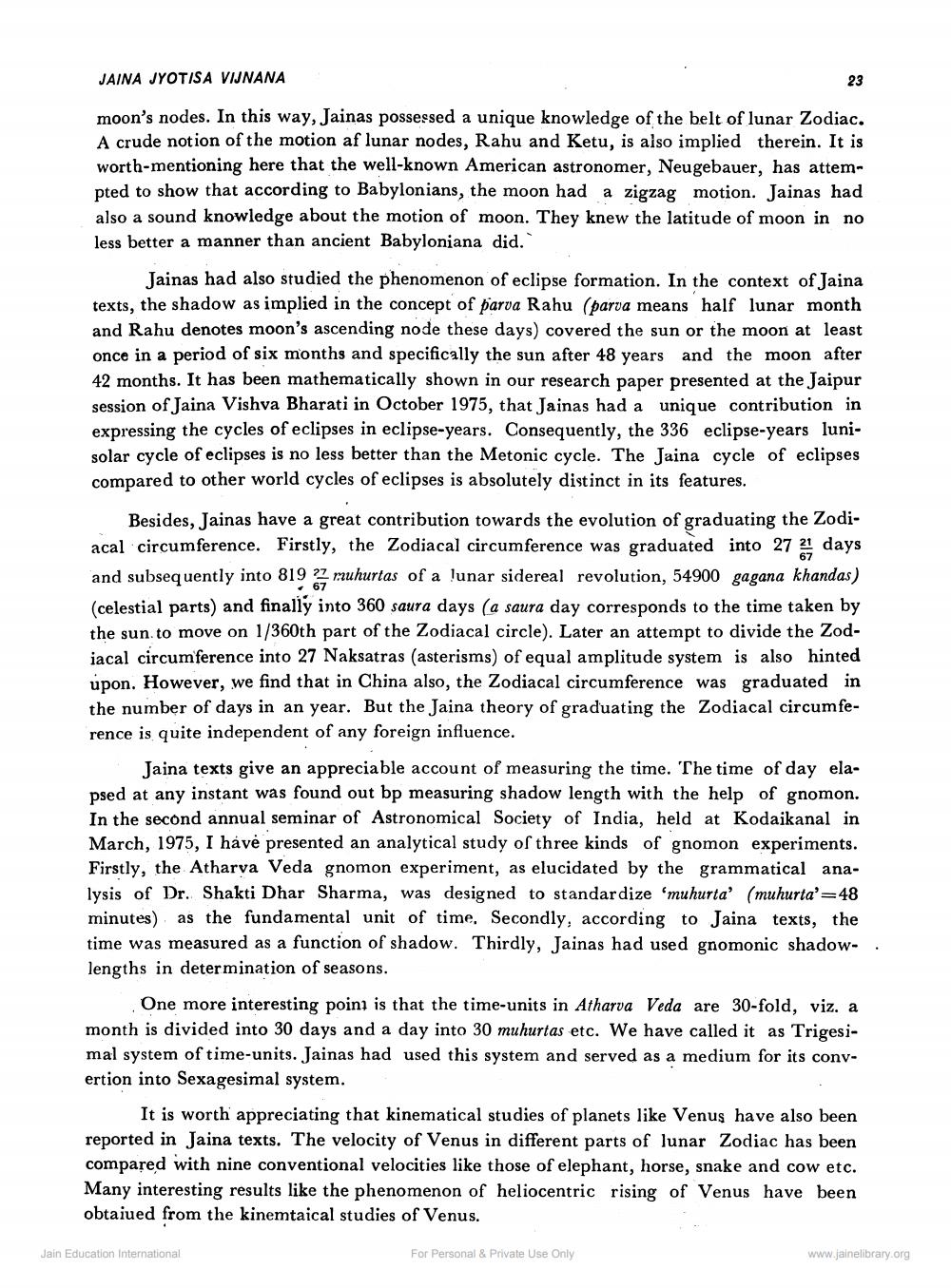________________
JAINA JYOTISA VIJNANA
moon's nodes. In this way, Jainas possessed a unique knowledge of the belt of lunar Zodiac. A crude notion of the motion af lunar nodes, Rahu and Ketu, is also implied therein. It is worth-mentioning here that the well-known American astronomer, Neugebauer, has attempted to show that according to Babylonians, the moon had a zigzag motion. Jainas had also a sound knowledge about the motion of moon. They knew the latitude of moon in no less better a manner than ancient Babyloniana did.
Jainas had also studied the phenomenon of eclipse formation. In the context of Jaina texts, the shadow as implied in the concept of parva Rahu (parva means half lunar month and Rahu denotes moon's ascending node these days) covered the sun or the moon at least once in a period of six months and specifically the sun after 48 years and the moon after 42 months. It has been mathematically shown in our research paper presented at the Jaipur session of Jaina Vishva Bharati in October 1975, that Jainas had a unique contribution in expressing the cycles of eclipses in eclipse-years. Consequently, the 336 eclipse-years lunisolar cycle of eclipses is no less better than the Metonic cycle. The Jaina cycle of eclipses compared to other world cycles of eclipses is absolutely distinct in its features.
23
67
Besides, Jainas have a great contribution towards the evolution of graduating the Zodiacal circumference. Firstly, the Zodiacal circumference was graduated into 27 days and subsequently into 819 22 muhurtas of a lunar sidereal revolution, 54900 gagana khandas) (celestial parts) and finally into 360 saura days (a saura day corresponds to the time taken by the sun. to move on 1/360th part of the Zodiacal circle). Later an attempt to divide the Zodiacal circumference into 27 Naksatras (asterisms) of equal amplitude system is also hinted upon. However, we find that in China also, the Zodiacal circumference was graduated in the number of days in an year. But the Jaina theory of graduating the Zodiacal circumference is quite independent of any foreign influence.
Jaina texts give an appreciable account of measuring the time. The time of day elapsed at any instant was found out bp measuring shadow length with the help of gnomon. In the second annual seminar of Astronomical Society of India, held at Kodaikanal in March, 1975, I have presented an analytical study of three kinds of gnomon experiments. Firstly, the Atharva Veda gnomon experiment, as elucidated by the grammatical analysis of Dr. Shakti Dhar Sharma, was designed to standardize 'muhurta' (muhurta'=48 minutes) as the fundamental unit of time. Secondly, according to Jaina texts, the time was measured as a function of shadow. Thirdly, Jainas had used gnomonic shadowlengths in determination of seasons.
One more interesting point is that the time-units in Atharva Veda are 30-fold, viz. a month is divided into 30 days and a day into 30 muhurtas etc. We have called it as Trigesimal system of time-units. Jainas had used this system and served as a medium for its convertion into Sexagesimal system.
It is worth appreciating that kinematical studies of planets like Venus have also been reported in Jaina texts. The velocity of Venus in different parts of lunar Zodiac has been compared with nine conventional velocities like those of elephant, horse, snake and cow etc. Many interesting results like the phenomenon of heliocentric rising of Venus have been obtaiued from the kinemtaical studies of Venus.
Jain Education International
For Personal & Private Use Only
www.jainelibrary.org




